Battle of Antietam or Sharpsburg
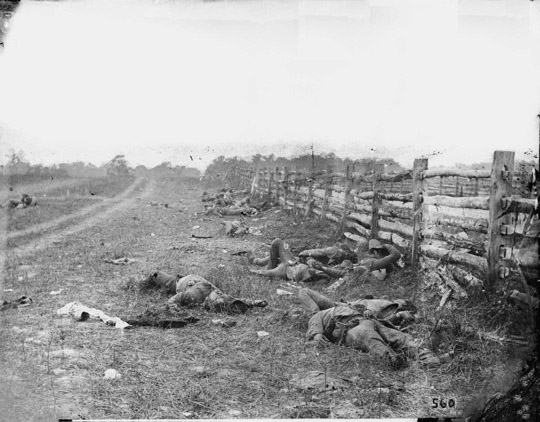
The Confederates tried to take the battle North into Union territory. In what became the bloodiest day in US history the Union defeated the Confederates at the Battle of Antietam
.
After his victory at Manassas, Lee had to decide what to do next. He could not maintain his current position, since there was no way he could obtain enough supplies for his army there. His choice was whether to advance or retreat. A retreat was an anathema to Lee. Therefore, his question became to decide where he would advance. Lee felt that Washington's defenses were too strong, so he hoped to head North towards Pennsylvania. His expectation was that he could force the Union army, which he believed were weak and demoralized, into a final fight. He thought this would assure Southern Independence.
Lee had made one very fundamental mistake. While the Union army had been hurt at Manassas, it was intact, and McClellan was back. While he may not have been the most aggressive general in history, McClellan was beloved by the troops. On September 5th, Lee moved his army into Maryland and occupied the town of Frederick. From there, Lee sent Jackson with 10,000 troops to Harpers Ferry (in his rear), to capture the garrison there. Simultaneously, he moved the bulk of the army westward to Boonsboro. The various parts of the army were then to reassemble. The plan was risky. It may have worked, but the orders were explicit, and a copy of these orders fell into Union hands. McClellan now knew the exact disposition and plans of the Confederate army.
McClellan's army now headed westward toward Boonsboro. Between the Union forces and the Confederates lay the South Mountains. A battle developed at Turner Gap and Crampton Gap, two passes through the mountains. The Confederates were not able to hold the line, and finally the passes were in Union hands. Lee considered withdrawing to Virginia. However, Jackson's quick victory over the Union garrison at Harpers Ferry convinced him to make a stand at the town of Sharpsburg. It had one great advantage, his lines could be anchored on the Potomac River. It was also his great weakness, if the battle went poorly, he would have no way to retreat.
On September 15th, Lee planted his army behind Antietam Creek. That evening McClellan and his army arrived on the other side of the Creek. For a day the armies stared at each other, as McClellan made his plans. Finally, the 17th of September dawned. It would be the bloodiest day in American History. As the battle opened, the Union outnumbered the Confederates, three to one. The day began with a flanking attack by Hooker’s corps. They started crossing a corn field, when they came under withering fire. The Union forces briefly retreated, and laid down withering cannon fire that completely leveled the corn field. Then, they advanced through the field, and reached Dunker’s Church, in the face of strong Confederate fire. Just as they arrived at the church, the Confederates counterattacked. They succeeded in driving the Union forces back across the corn field. At that point a new attack was launched by General Mansfield corp( he was soon killed) which once again crossed the field, only to be repulsed at the last moment.
The battle on the North side of the town had now ended, but a second battle soon began, as General Sumner’s corps attacked the Confederate center. The battle quickly centered along the sunken road. Initially, the sunken road was an excellent defensive position. However, once the Union troops advanced, the road became a mass grave for Confederate soldiers, who were trapped in the trench. The Union troops almost broke through the center of the Confederate lines, but the Union advance petered out.
Finally, the third battle of the day began. Union troops, under Burnside, fought their way across the lower bridge– the bridge that soon bore Burnside’s name. Union troops advanced toward Sharpsburg, but at the last moment, A.P. Hill’s division arrived from Harpers Ferry, and managed to break the attack, with a well-timed counterattack. That ended the fighting for the day. The battle was a draw. It was a tactical victory for the Confederates, as they had held off a force that was much greater than their own.
Once again, McClellan's conviction that he faced a force larger than his own, made him hesitate when he should have attacked with his unused forces. The war might have ended that day. However, McClellan hesitated. A few day later, Lee withdrew. General Lee withdrew, for the Confederates, even more than the Union forces could not long endure the suffering of that day on the ground around Sharpsburg. 23,582 Americans were killed that day. The ground around Sharpsburg was littered with corpses. As a NY Volunteer wrote:
"Before the sunlight faded, I walked over the narrow field. All around lay the Confederate dead- undersized men mostly, from the coast district of North Carolina, with sallow hatchet faces, clad in "butternut"- a color running all the way from a deep, coffee brown up to the whitish brown of ordinary dust. As I looked down on the poor, pinched faces, worn with march and scant fare, all enmity died out. There was no secession in those rigid forms, nor, nor in those eyes staring blankly at the sky. Clearly it was not their war."
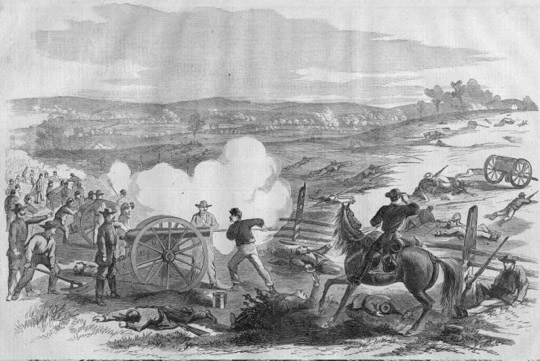
1st Maryland at Antietam. This drawing which originally appeared in Harpers Weekly was sketched by Mr A R Waud

Antietam, Maryland. 93rd New York Infantry, headquarters Army of the Potomac September 1862.
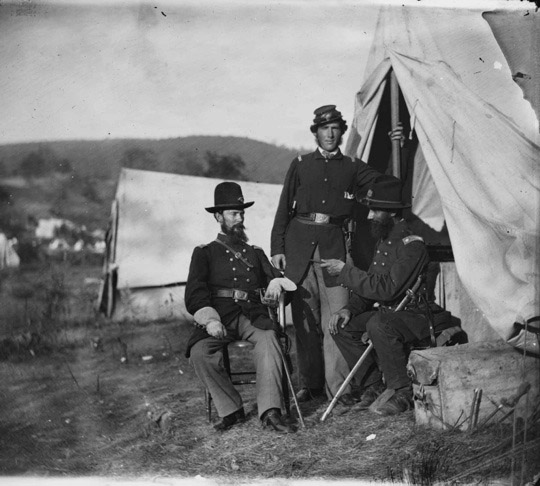
Antietam, Md. Col. John S. Crocker, Lt. Col. Benjamin C. Butler, and adjutant of 93d New York Volunteers September 1862
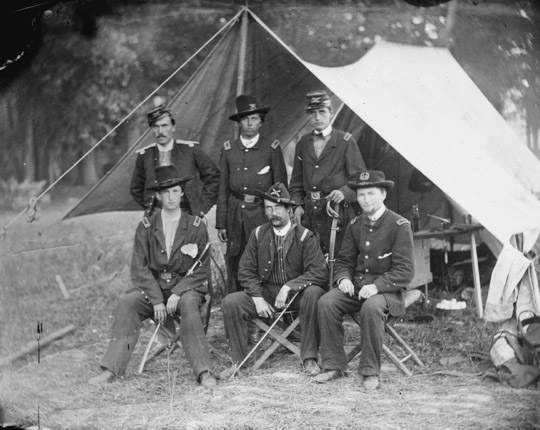
Antietam, Maryland. Lt. Rufus King, Lt. Alonzo Cushing, Lt. Evan Thomas and three other officers
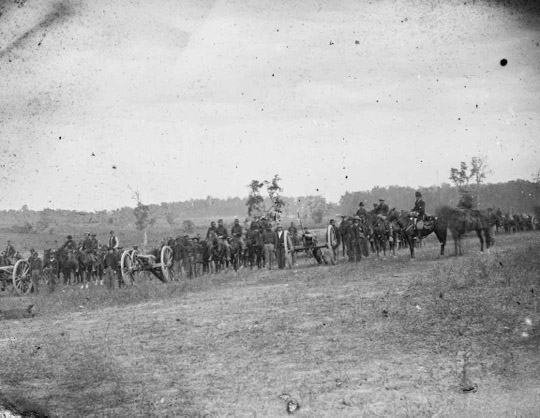
Capt. J. M. Knap's battery. Penn. artillery (Banks Corps) on battlefield of Antietam. Sept. 1862.
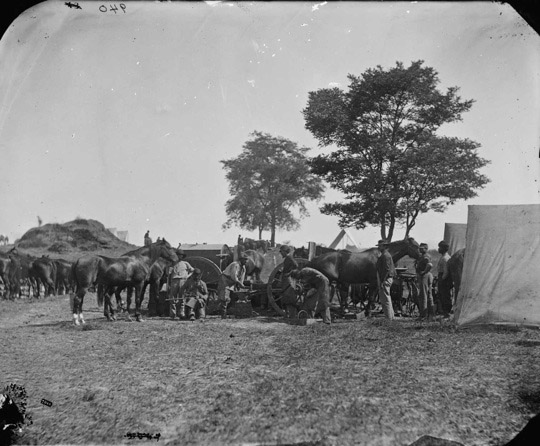
Blacksmith shoeing horses at headquarters, Army of the Potomac Antietam September 1862
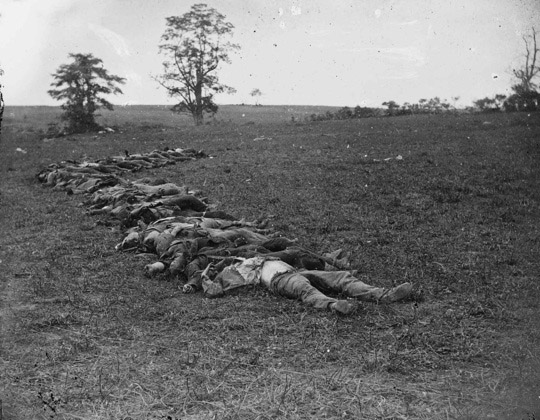
Antietam, Md. Bodies of Confederate dead gathered for burial
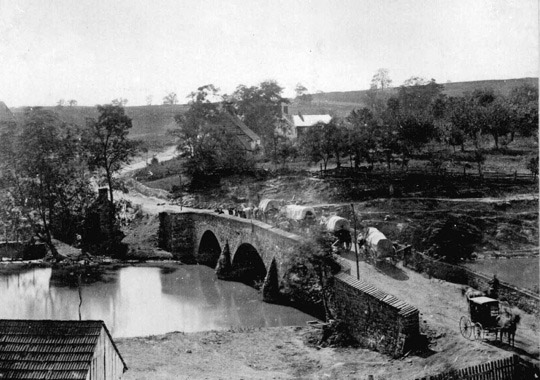
John Gardner s Photograph of Union soldiers crossing the bridge.
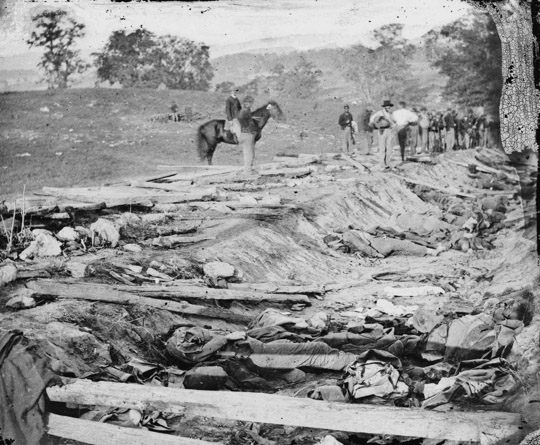
Antietam, Md. Confederate dead in a ditch on the right wing used as a rifle pit September 1862..
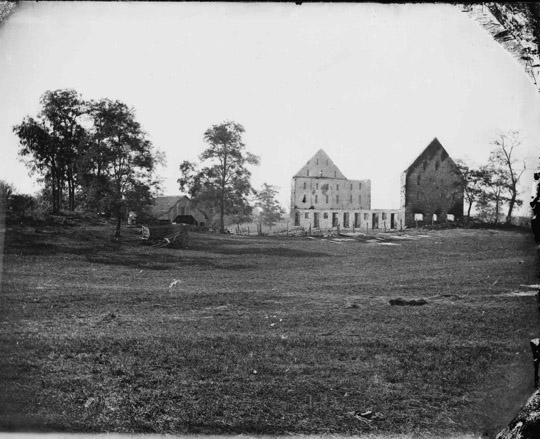
Antietam, Maryland. Real's barn, burned by the bursting of a Federal shell at the battle of Antietam September 1862.
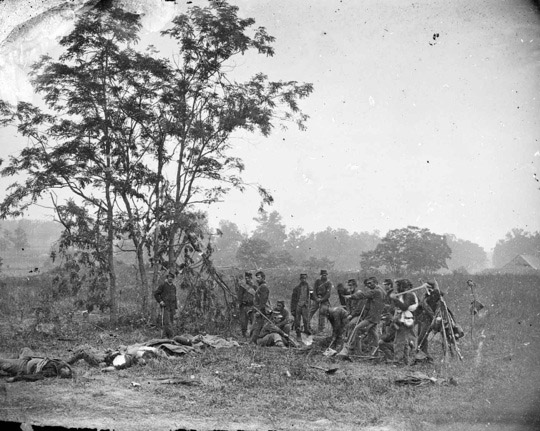
Antietam, Maryland. Burying the dead Confederate soldiers.
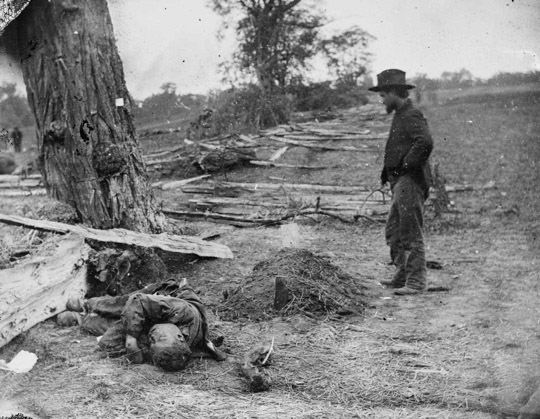
Antietam, Maryland. Federal buried, Confederate unburied, where they fell.
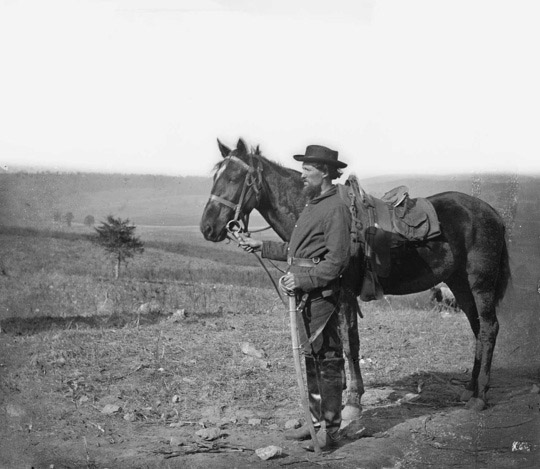
A Cavalry orderly at Antietam in October 1862..
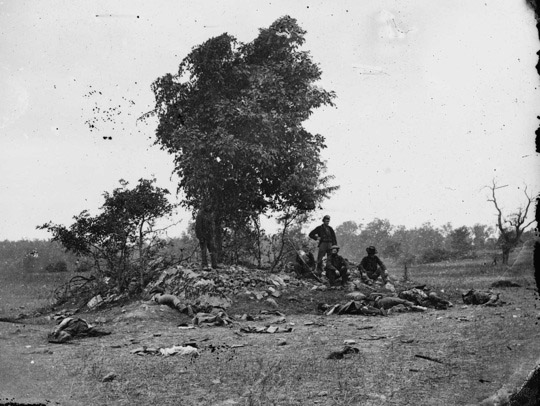
Confederate dead on the Miller farm, looking toward the west woods Antietam September 19, 1862

Keedysville, Md., vicinity. Confederate wounded at Smith's Barn, with Dr. Anson Hurd, 14th Indiana Volunteers, in attendance.

Bodies in front of Danker Church?Antietam, Maryland. Bodies in front of the Dunker church, September 1862
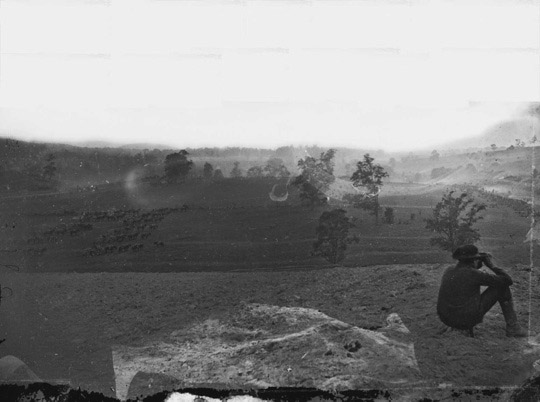
View of Battlefield Day 1 -September 17, 1862 day view of the battlefield.
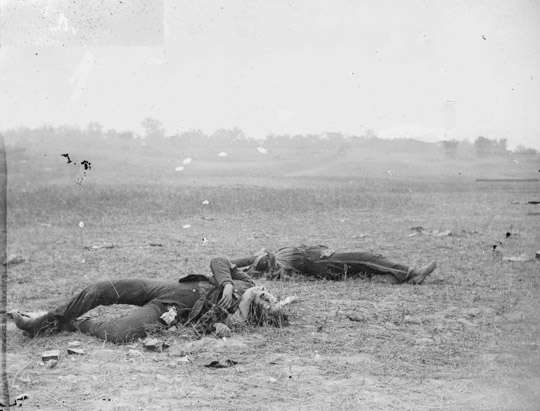
Antietam, Maryland. Confederate soldiers as they fell near the Burnside bridge.
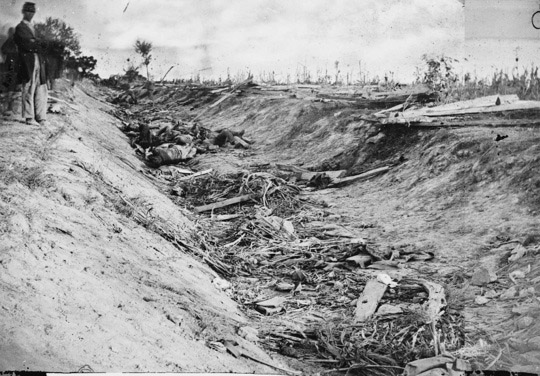
Antietam, Md. Confederate dead in a ditch on the right wing
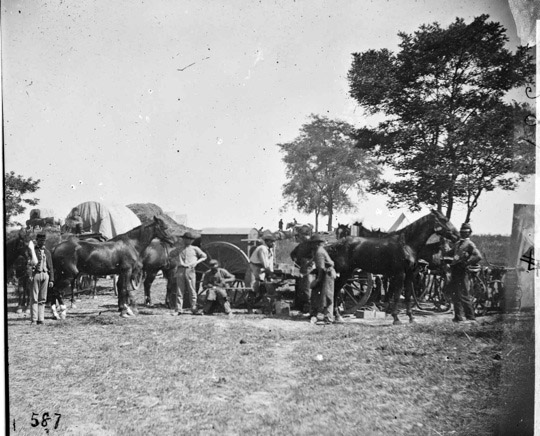
Antietam, Maryland. Forge scene at General McClellan's headquarters

Antietam, Md. Confederate dead by a fence on the Hagerstown road September 1862

This drawing shows General Mansfield Corps in the centre as well as other scenes.All of the images were sketched by Mr A R Waud with the lower right drawing showing the burning of Mumm' house and Barns and the lower right drawing showing carrying the wounded after the battle.

Antietam, Maryland. Gen. Joe Hooker's headquarters. September 1862
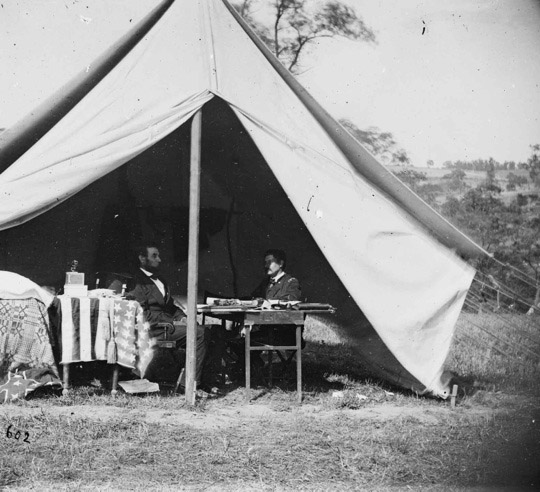
Photograph of President Lincoln and Gen. George B. McClellan in the general's tent on October 3, 1862.
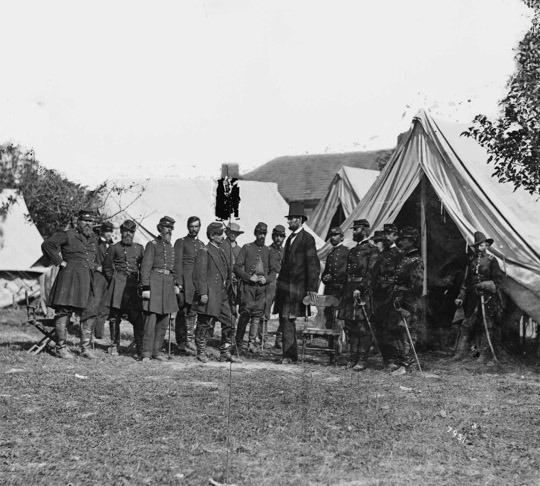
Battle of Antietam, September-October 1862. 1. Col. Delos B. Sacket, I.G. 2. Capt. George Monteith. 3. Lt. Col. Nelson B. Sweitzer. 4. Gen. George W. Morell. 5. Col. Alexander S. Webb, Chief of Staff, 5th Corps. 6. Gen. George B. McClellan. 7. Scout Adams. 8. Dr. Jonathan Letterman, Army Medical Director. 9. Unknown. 10. President Lincoln. 11. Gen. Henry J. Hunt. 12. Gen. Fitz-John Porter. 13. Unknown. 14. Col. Frederick T. Locke, A.A.G. 15. Gen. Andrew A. Humphreys. 16. Capt. George Armstrong Custer.

Antietam, Maryland. Lt. Col. Charles B. Norton at headquarters of Gen. Fitz-John Porter.

 >
>